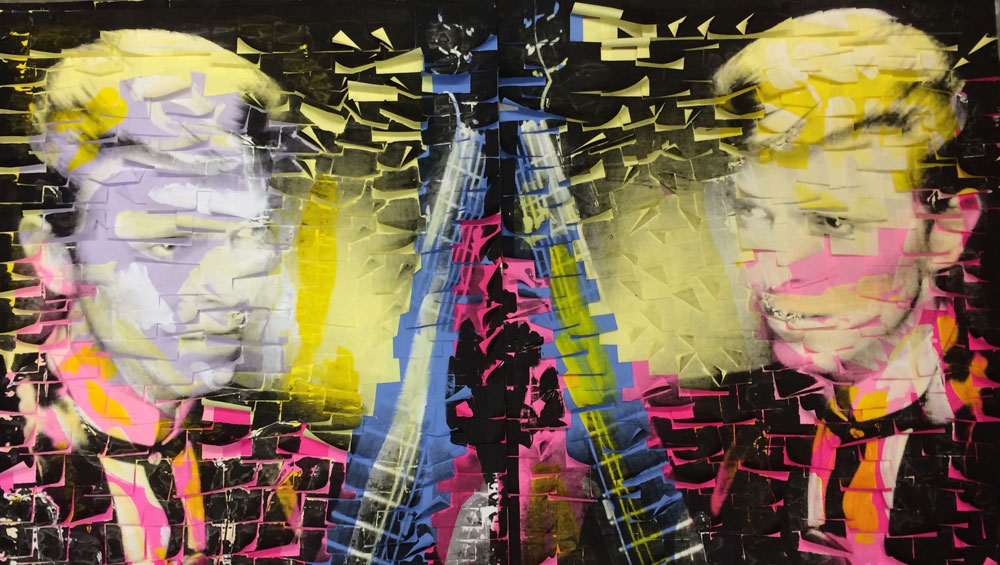
by NATASHA KURCHANOVA
Ardan Özmenoğlu (b1979, Ankara) is a Turkish artist who exhibits internationally. She makes mostly representational works out of Post-it notes, along with sculptures made from glass and other materials, for example toothpicks, employing the method of repeating one element several times. She also makes installations and site-specific sculptures with neon inscriptions, delivering messages circumscribed by the time and place of the exhibition.
Natasha Kurchanova: You recently had an exhibition of your Post-it works and glass sculptures at Emmanuel Fremin Gallery in New York. Could you tell me about it?
Ardan Özmenoğlu: It’s been six years since my last exhibition in the US, when I showed at the Bertrand Delacroix Gallery, also in New York. Six years is a long time. At the Emmanuel Fremin Gallery, I showed works I have been making for a while: prints and paintings made from Post-it notes and sculpture made from several layers of uniform panels of glass.
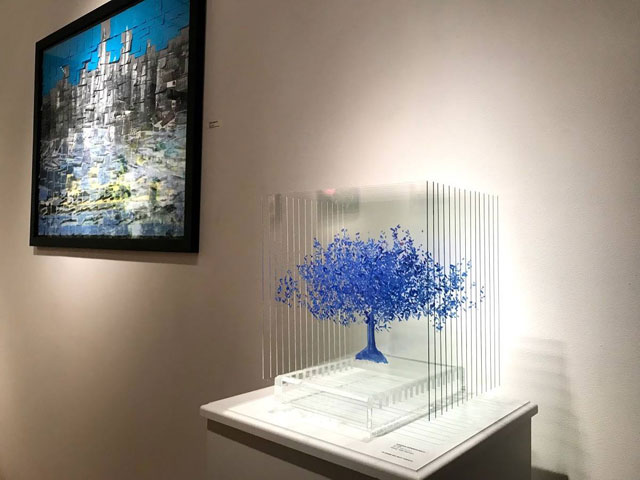
Ardan Özmenoğlu. Installation view of Post-It, 14 June – 28 July 2018. Photograph courtesy Emmanuel Fremin Gallery.
NK: You have been exhibiting Post-it works and glass sculpture for several years. How did you develop this style?
AÖ: It started when I was finishing my master’s degree. I began making Post-it works in 2005. This style developed itself in a way, because I worked on these for years. First, it was just one print on a Post-it note, and now there are so many layers on it: painting, writing, glitter, spray paint, several layers of notes … It is constantly changing; it’s not just a simple use of a Post-it. How I use a Post-it changed, too. I started to install them; I am using them in a freer way. Sometimes, I use only one Post-it; sometimes 10, sometimes hundreds. Sometimes, I cover the entire surface of an exhibition space with them. I play with the Post-it, and it plays with me, too. When you work so much with one medium, you realise that there are many possibilities in using it.
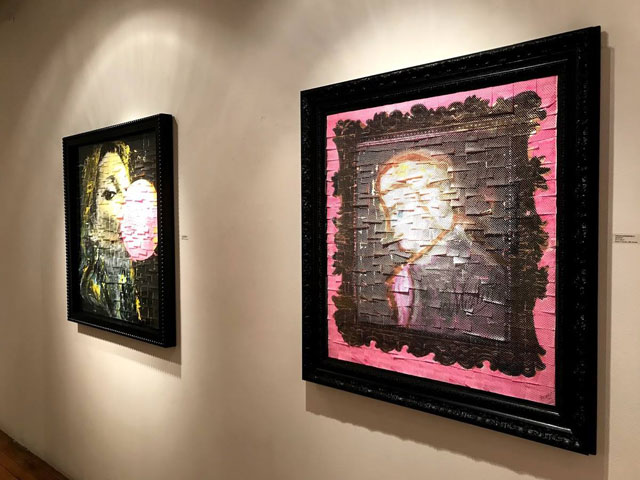
Ardan Özmenoğlu. Installation view of Post-It, 14 June – 28 July 2018. Photograph courtesy Emmanuel Fremin Gallery.
NK: You experiment with it in different ways.
AO: Yes, I do. My Post-it works look different now. Nowadays, people ask me: “What is it? Is it velvet? Is it a textile?” They are surprised to find out that what I show them is basically a Post-it note, because the work sometimes does not look like it.
NK: Could you tell me how you work with Post-its?
AÖ: I used to print on them, but now I paint on them more than I print. That is why I call them Post-it paintings. At Emmanuel Fremin Gallery, I exhibited both printed and painted Post-it paintings, because the works exhibited there were made over a wide span of time, from 2014 to 2017.
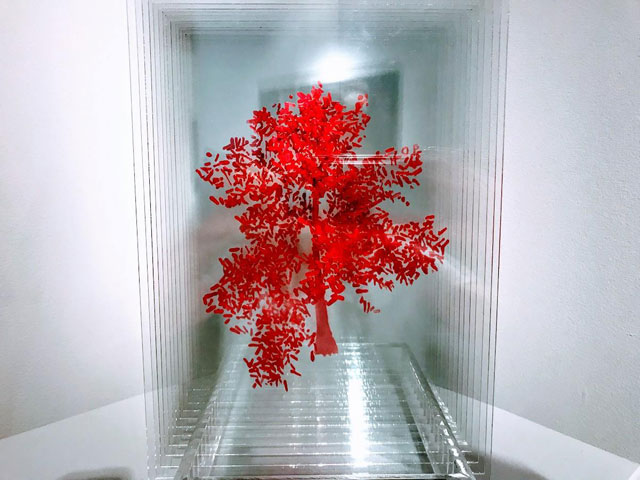
Ardan Özmenoğlu. Installation view of Post-It, 14 June – 28 July 2018. Photograph courtesy Emmanuel Fremin Gallery.
NK: Apart from Post-it works, you also showed glass sculptures at Emmanuel Fremin. Could you tell me about them?
AÖ: I think my Post-it paintings and glass sculptures are very similar, because both are made with layers. Sometimes, Post-it works have so many layers in them that they look like three-dimensional paintings. For sculptures as well, I use 15 to 20 layers of glass sheets. Also, Post-it paintings and glass sculptures are quite fragile, of course. Both have to be handled with care.
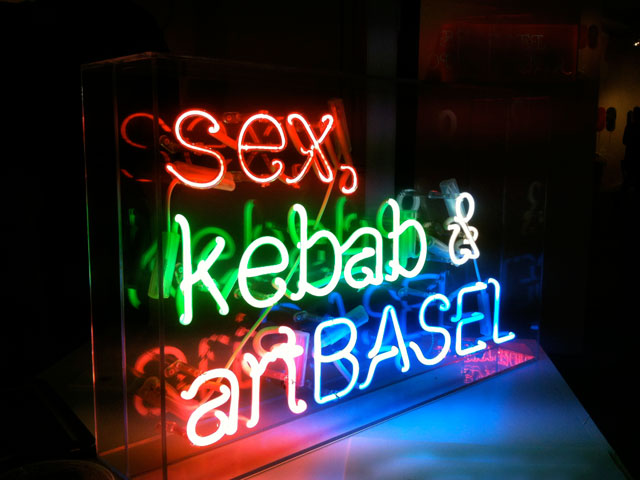
Ardan Özmenoğlu. Sex, Kebab, and Art Basel, 2013. Neon tubing, 60 x 80 cm. Photograph courtesy of the artist.
NK: So, you create a tension between surface and three-dimensionality; flatness and volume, and fragility and the need for preservation in the work. It makes sense that you frequently show them together, because they interact with each other. What about your other work, such as neon lighting, which I saw on your website. You did not show it in New York. Why?
AÖ: I use neon in my work to fit the context and deliver my message. Most of my neon works are site-specific and relate to daily life, which is why I do not show most of them abroad, but only in Turkey. In Turkey, as you may know, there is a lot of neon. I create these works for particular events and exhibit them in Istanbul. They concern particular localities and can be understood best when shown in the context for which they were made. Each can have a long story written about it. For example, I created one neon work for Art Basel in 2013. And it was the hit work for that show because I made it exactly for that big art fair. Hundreds of people asked to buy it, but there was only one edition. In at least one work so far, I have used neon and Post-its together – it’s a Post-it painting with an inscription in neon on the bottom, saying: “Do you like my work ha?” In the future, I think I will begin combining media in a more consistent way – glass sculpture, Post-its, neon together. I realised that it is going this way, because I created this one piece.
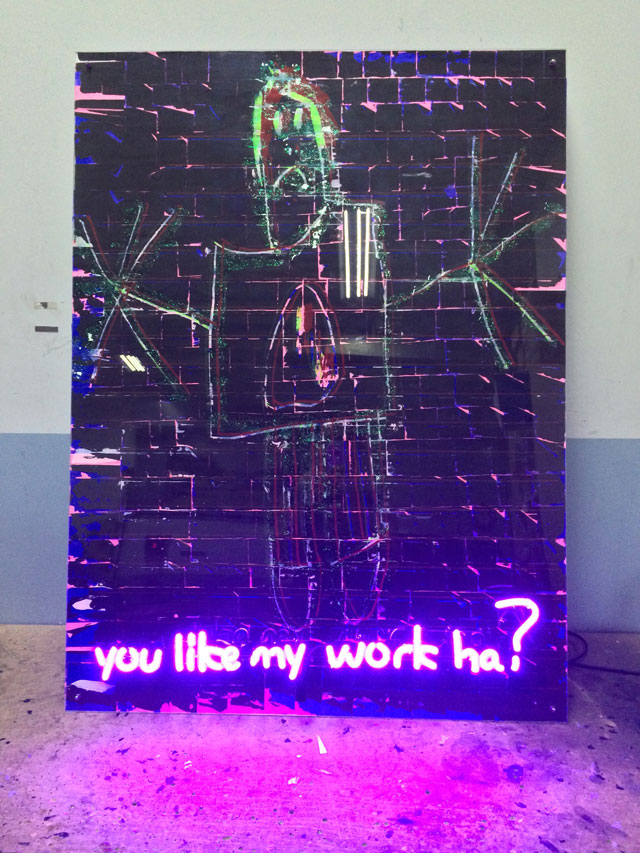
Ardan Özmenoğlu. You Like My Work, Ha? 2013. Neon tubing on post-it notes, 80 x 110 cm. Photograph courtesy of the artist.
NK: A while ago, you made sculptures out of ceramic – entire installations, in fact. Can you tell me about these?
AÖ: I can tell you about two installations: one I made with ceramic – A Dream of a Man (2009) – and the other one with Post-it notes – Laundromat (2012). For me, both have the same concept, multiplicity. In showing similar things in a non-uniform way, I wanted to show how we see things differently. I love to play with our daily routines, and I like to think that both works convey a similar humorous message. In A Dream of a Man, I depict pairs of female breasts of seemingly infinite variety installed on the wall almost right up to the ceiling. The breasts here become highly individualised and thus, in each case, unique objects, in opposition to the conventional idea of a “dream of a man”. Where individual breasts are laid out on the wall, they come across as flotsam on the beach.
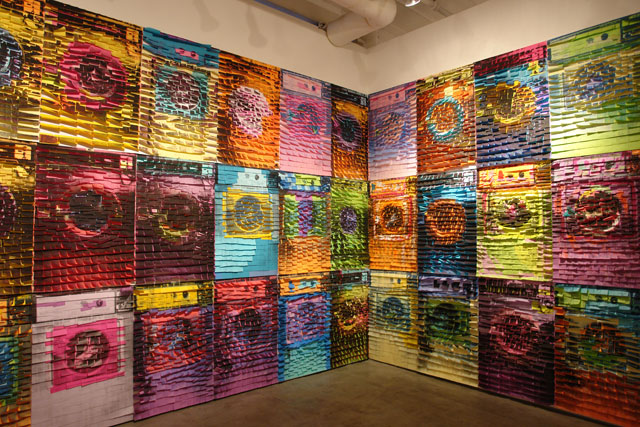
Ardan Özmenoğlu, Laundromat, 2012. Mixed media on post-it notes, dimensions variable. Photograph courtesy of the artist.
Laundromat is also double-edged: it conveys political humour and plays with the viewer. It says “yes” to affordable services, democracy and local community life. Instead of having your own washing machine, you share, you meet and communicate in laundromats. So, a laundromat is for everybody, for all life circumstances: it offers real freedom. From this perspective, it´s again very modern as a way of thinking about ecology, sustainability and independence. The work’s three-dimensionality also translates into a depth of meaning – on the surface, it is colourful, lighthearted and fun, yet an entirely different character and tone threatens to eclipse these surface appearances from underneath. Like a Post-it note, which you use once and then throw away, the washing machine is used until it breaks down.
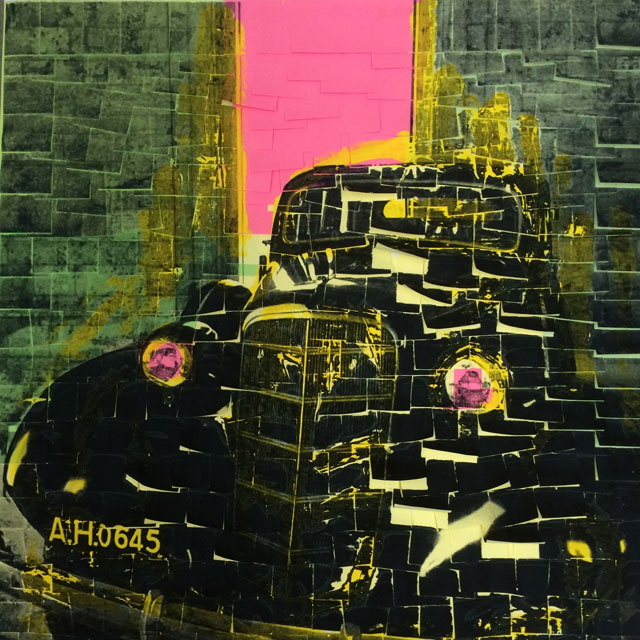
Ardan Özmenoğlu. Get into my Car (Ataturk’s Car), 2016. Mixed technique on post-it notes, 94 x 94 sm. Photograph courtesy Emmanuel Fremin Gallery.
NK: A lot of your art is about repetition, in which you repeat one element several times – a toothpick, a ceramic shape, a Post-it, a sheet of glass … In all these works, you use the logic of the multiple for aesthetic purposes. Can you say a few words about it?
AÖ: For me, repetition is the only way that you can reach perfection. Edgar Degas once said: “One must do the same subject over again 10 times, a hundred times. In art nothing must resemble an accident, not even movement.” I feel as if my work is moving in a certain direction now, no matter what medium, because it is guided by one idea.
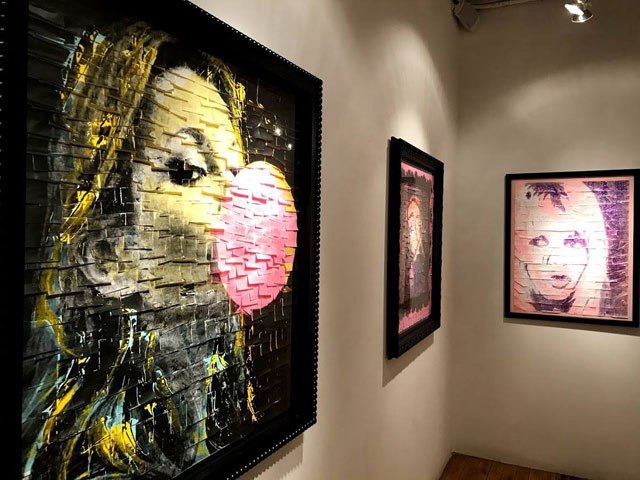
Ardan Özmenoğlu. Installation view of Post-It, 14 June – 28 July 2018. Photograph courtesy Emmanuel Fremin Gallery.
NK: I have a question about the contextual aspect of your work. Your early Post-its referenced Turkish history a lot, with portraits of sultans and images referring to Atatürk. Can you tell me more about this?
AÖ: Political commentary is very important in my work. It’s not necessarily direct, but it says something indirectly. The very appearance of this art, which is rather unconventional by traditional standards, is already a political statement of sorts.
NK: How easy is it for an artist such as yourself to exhibit in Istanbul now?
AÖ: It is easy to exhibit in Istanbul, but the problem is not in showing, but in having a public with no interest for contemporary art, because the focus is on traditional and classical art. Contemporary artists there still create work and exhibit, but it is difficult in terms of public support. We have the art fair Contemporary Istanbul, which this year takes place on 20-23 Septemberand is celebrating its 13th year. After that art fair, I will have a solo show in Istanbul and Geneva.
NK: What have you been doing since your last exhibition in New York, six years ago?
AÖ: I lived in Vienna for one month in 2016, where I was an artist-in-residency. I had a solo show at the Osthaus Museum Hagen in Germany. I also had exhibitions in Zagreb, Athens, London, Geneva, Mumbai and in Cafmeyer Gallery, Knokke, Belgium. In between all these trips, I come back to Istanbul.
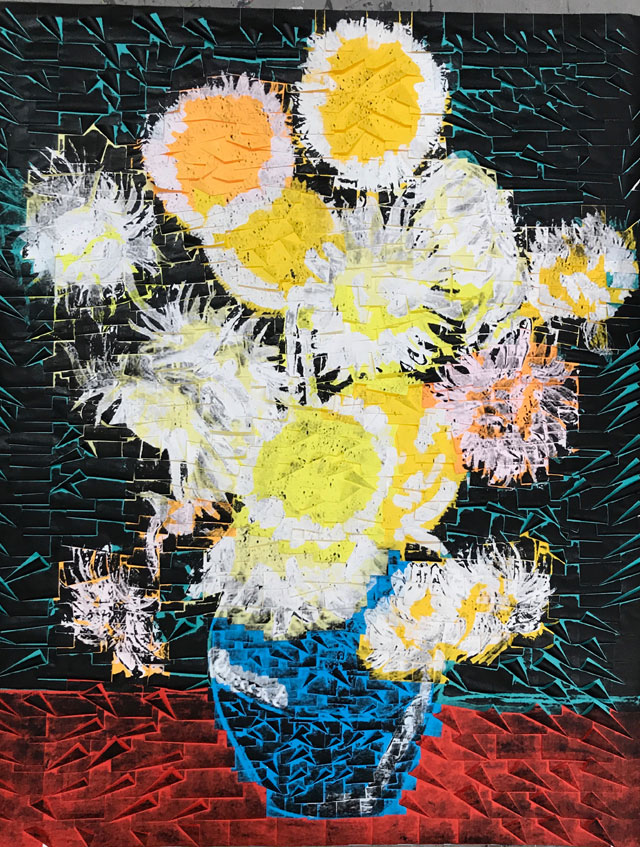
Ardan Özmenoğlu. Vincent vs Ardan, 2016. Mixed technique on post-it notes, 153 x 122 cm. Photograph courtesy Emmanuel Fremin Gallery.
NK: Who among artists was helpful for you in developing your own vision in art?
AÖ: Many classical modern painters influenced me: Matisse, Van Gogh, Rothko … Each of them inspired me differently. I love looking at art in general. When I went to New York, I visited all the museums. There is so much inspirational art for me there. I take it all in and then make something of my own. This is why I cannot give just a single name. All art and artists move me.
NK: Could you talk a bit about your training?
AÖ: I went to Bilkent University in Ankara and received my MFA there, as well. I studied there under Alexander Djikia. I finished my master’s in 2006, and then my teacher suggested I study at the Kala Art Institute in Berkeley. I was an artist-in-residence there for six months. That’s how it all started. Then other artist residencies followed. You know how it goes, eventually everything connects.
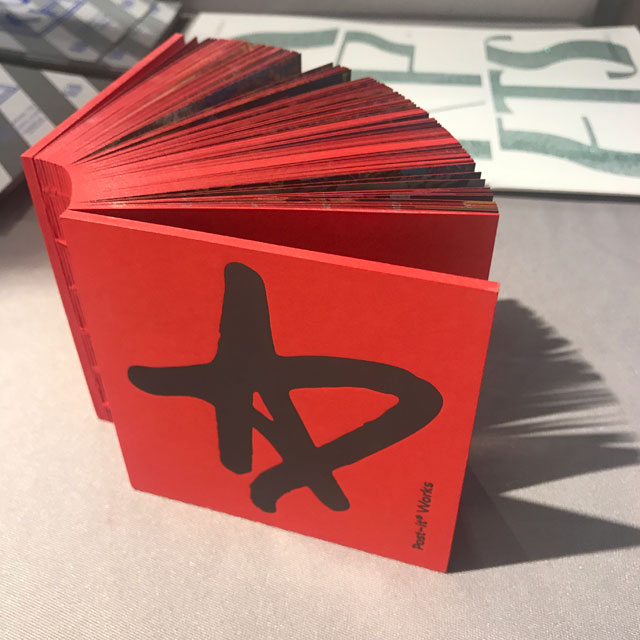
Ardan Özmenoğlu. Post-It Works, 2005-2017 (Istanbul: MASA, 2017).
NK: What’s your next project?
AÖ: In Turkey, in a small town in Izmir called Urla, I will transform an old soap factory into an art space. Architects for this project are collaborating with me now. It’s a historic place. I am planning to have an exhibition in that space with its own identity. Also, I have just finished a book about my work. It looks like an art object; a Post-it block about 10cm x 10cm, which includes only my Post-it works between 2005 and 2017. The MET library recently acquired it for its archive.